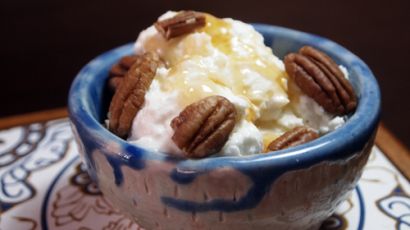|
Ricotta wasn't something I liked too much when I was a boy. Ok, I didn't like it at all. Too creamy, a bit sour to my taste buds and the texture was often a bit grainy. I'm still not a fan of eating it straight, or nel nudo... er... undressed. I don't even like white pizza with ricotta. That's Lisa's thing. But as my tastes have evolved and I've grown as a cook, I've learned to appreciate ricotta as an ingredient or an accompaniment for other foods. Fresh ricotta (especially when Lisa makes some) is great with a little honey drizzled over it and some fresh fruit--berries or figs. Even jam and ricotta is great on a Ritz cracker. Of course, as an ingredient for stuffed shells or lasagna it's indispensable. I even like when it's stuffed into huge olives. And I use it often to enrich sauces... besciamella, marinara, and even to make a creamy-cheesy pesto. Recently I used ricotta in a stuffed French toast breakfast. That really works! But, my all time favorite way to enjoy ricotta is when Lisa makes her Italian Cheesecake (almond flavored) around the holidays. I won't go so far as saying that I loved the powerfully stinky, burn your eyes out Ricotta Forte we tasted in Puglia, although Lucas seemed to go for it. Interesting that now that he's nearing puberty, his feet are starting to smell just like Ricotta Forte... (Lucas just read this and thinks I'm being mean.)  Ricotta, pecans & honey Ricotta, pecans & honey Now I've heard rumors that ricotta isn't really a cheese at all, because it doesn't contain what most cheese do... casein. It is made from the whey leftover--usually after--another cheese has been made (like mozzarella). This is what "ricotta" means... literally, "twice cooked". Because ricotta doesn't contain casein, people can digest it a lot easier than other cheeses... with no side effects for people sensitive to such matters. (I'm staying mute on that subject). But in reality both casein and whey are each components of the proteins in milk, and believe it or not, there are people who might still be bothered in a big way by ingesting whey instead of casein. And for the lactose intolerant out there... yes, it does contain lactose! Steer clear.  A simple way to drain fresh ricotta A simple way to drain fresh ricotta So, leaving the semantics aside... you can consider ricotta a cheese. (It's like the never-ending Sauce - Gravy debate about what a red marinara cooked all day with meat is called). Embrace the concept. It's not simply another "dairy product". It's a cheese. Oh, one other thing... A lot of people think of ricotta as a diet cheese, and although it is relatively low in fat, it still contains anywhere from 10-20% fat. So don't overdo it. (I actually don't like it when Lisa overdoes the ricotta in a lasagna--eat heart healthy!) If you want to be sure the ricotta you eat is lower in fat, buy only artisanal ricotta--or make it yourself at home. The store bought, packaged stuff is always going to be higher in fat. As I mentioned before, ricotta means cooked twice. It is made from either sheep, cow, goat or water buffalo milk whey that's been left over after making another cheese. The "twice cooked" comes into the picture because the whey is heated almost to a boil either after fermenting to make it more acidic--or like Lisa does--by adding lemon juice for the acidity. This technique allows a second curd to develop from the whey that was leftover. To form a cheese, the curds are collected and shaped by hanging in a cheesecloth or by placing into special cheese baskets which allow the liquids to drain while leaving the curds behind. If you add a bit more salt and allow it to dry for much longer, you might even make ricotta salata, a salty, firm cheese similar to Greek feta. You know, now that I think about it, Lisa hasn't made any for about two months of more... nudge, nudge... get the hint, Sweetie? --Jerry Finzi If you enjoyed this post, please share it with your friends and all the cheesy people you know. Grazie!
0 Comments
Your comment will be posted after it is approved.
Leave a Reply. |
Categories
All
Archive
June 2024
|





 RSS Feed
RSS Feed
